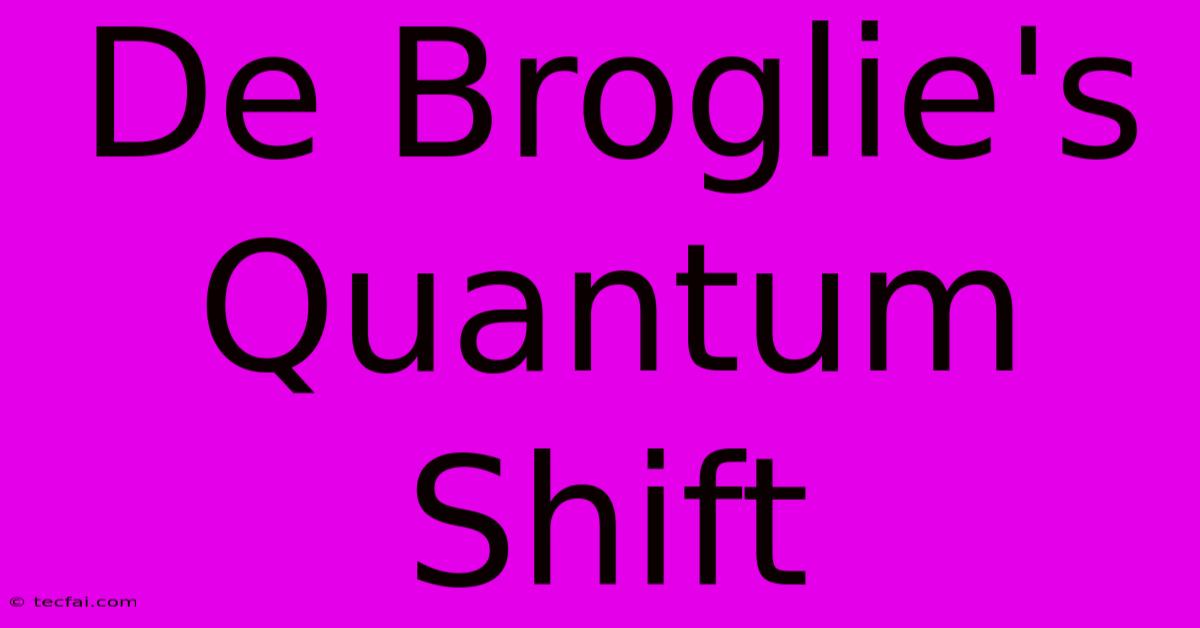De Broglie's Quantum Shift

Discover more detailed and exciting information on our website. Click the link below to start your adventure: Visit Best Website tecfai.com. Don't miss out!
Table of Contents
De Broglie's Quantum Shift: Wave-Particle Duality and the Dawn of Quantum Mechanics
Louis de Broglie's revolutionary hypothesis in 1924 fundamentally altered our understanding of the universe, ushering in a new era of physics: quantum mechanics. His audacious proposal, that matter possesses wave-like properties, a concept now known as wave-particle duality, completely reshaped our comprehension of the subatomic world and laid the groundwork for many subsequent breakthroughs. This article delves into De Broglie's pivotal contribution, exploring its implications and lasting legacy.
The Genesis of a Revolutionary Idea
Before De Broglie, the scientific community held a distinct separation between waves and particles. Light, characterized by its wave-like behavior (diffraction, interference), was considered fundamentally different from matter, which was understood as consisting of discrete particles. However, Einstein's groundbreaking work on the photoelectric effect, demonstrating light's particle-like nature (photons), hinted at a deeper, more unified reality.
De Broglie, inspired by this duality in light, dared to propose the inverse: if light, traditionally considered a wave, could exhibit particle-like properties, then perhaps matter, traditionally considered a particle, could exhibit wave-like properties. He posited that every particle, regardless of its mass, possesses an associated wavelength, a relationship now famously expressed by his equation:
λ = h/p
Where:
- λ represents the wavelength
- h is Planck's constant
- p is the momentum (mass x velocity) of the particle
This seemingly simple equation had profound implications. It suggested that electrons, protons, and even macroscopic objects, albeit with incredibly small wavelengths, possess wave-like characteristics.
Experimental Verification and the Birth of Wave Mechanics
De Broglie's hypothesis was initially met with skepticism. However, experimental verification soon followed. The Davisson-Germer experiment in 1927, which demonstrated the diffraction of electrons, provided crucial evidence supporting De Broglie's theory. This experiment, along with others showcasing the wave nature of matter, solidified wave-particle duality as a cornerstone of quantum mechanics.
This breakthrough paved the way for the development of wave mechanics, a mathematical framework for describing the behavior of quantum systems, primarily developed by Erwin Schrödinger. Schrödinger's equation, a cornerstone of quantum mechanics, directly incorporates De Broglie's wavelength into its formulation.
Implications and Lasting Legacy
De Broglie's work profoundly impacted our understanding of the universe at its most fundamental level. His theory:
- Explains the quantization of electron orbits in atoms: The stable orbits of electrons around the nucleus can be understood as standing waves, where only specific wavelengths (and thus energy levels) are allowed.
- Underpins the development of electron microscopy: The wave nature of electrons allows for their use in microscopes capable of achieving far higher resolution than traditional optical microscopes.
- Provides a framework for understanding other quantum phenomena: Wave-particle duality is crucial for understanding concepts like quantum tunneling and quantum entanglement.
De Broglie's contribution was so significant that he was awarded the Nobel Prize in Physics in 1929, a testament to the revolutionary impact of his work. His hypothesis not only changed our understanding of the physical world but also highlighted the limitations of classical physics in describing the quantum realm.
Further Exploration: Beyond the Basics
While De Broglie's equation provides a powerful tool for understanding the wave nature of matter, it's important to acknowledge its limitations. The wave-particle duality is not a simple superposition of wave and particle properties; it represents a fundamentally different way of understanding reality at the quantum level. Exploring the interpretations of quantum mechanics, such as the Copenhagen interpretation or the many-worlds interpretation, offers further insight into this fascinating and complex subject. Further research into quantum field theory provides a more complete and modern understanding of this duality.
De Broglie's quantum shift represents a paradigm shift in physics, forever changing how we perceive the universe at its smallest scales. His legacy continues to inspire researchers and students alike, pushing the boundaries of our knowledge and understanding of the quantum world.

Thank you for visiting our website wich cover about De Broglie's Quantum Shift. We hope the information provided has been useful to you. Feel free to contact us if you have any questions or need further assistance. See you next time and dont miss to bookmark.
Featured Posts
-
Arsenal Rout Artetas Landmark Comment
Nov 27, 2024
-
Aberdeen Loss Inside The Dons Dressing Room
Nov 27, 2024
-
Fc Barcelona V Brest Preview
Nov 27, 2024
-
Sa Vs Sl Playing 11 Live Score 1st Test Match
Nov 27, 2024
-
Bonnie Blues Three Word Statement Divides Viewers
Nov 27, 2024
